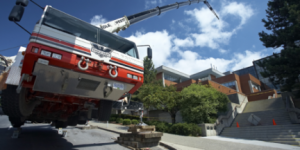Construction work can be dangerous if you do not follow safety rules and guidelines while at work. There are a high number of construction fatalities each year compared to all of the other workplaces put together. Why this occurs remains a mystery, one can only assume it is because supervisors are not enforcing safety regulations, construction workers are not following safety procedures as they should be or that the guidelines that have been put in place are simply not enough.
Falling from a roof accounts for 10% of construction deaths, followed by being crushed or run-over by equipment operated by a co-worker (9%) and falls from structures other than roofs (8%). One out of every seven construction related deaths involve someone crushed or hit by falling or moving objects.
Statistics show that crane related accidents are the most common cause for construction site fatalities. When a crane is used properly it is a tremendous tool that provides lifting solutions in all forms of construction. When used incorrectly it can be a killing machine.
Only about 10% of crane incidents are caused by some type of mechanical malfunction. The remaining accidents are due to poor maintenance, overturned cranes, dropped loads, booms collapsing, improper set up, working beyond capacity and worker`s operating the crane when they are not certified to do so.
It is important to make sure the person operating the crane has gone through the proper safety courses and graduated with a certificate that states the restrictions regarding the cranes they are certified to operate.
While a crane may seem simple they are actually complex machines and require a person that is skilled in operating them to function correctly. If you allow a non-certified person to operate the crane that results in a major incident or injury, you and the person operating the crane will be subject to a formal investigation. This may lead to fines, loss of business and even jail time depending on the severity of the accident.
Prevention
There are several things that can be done to prevent construction fatalities. The number one way to prevent fatalities is to educate your workforce about working safely:
1. Always complete New Worker and Young Worker Safety Orientations prior to starting work
2. Train and certify your workers in the proper use of all tools and machinery that they are required to work with or exposed to on a daily basis
3. Teaching your workers how to complete the task safely will ensure they do it correctly every time
4. Identify the hazards associated with the task prior to assigning or starting the task
5. Assess the risk associated with the hazards identified (exposure, probability and consequence)
6. Establish all necessary hazard controls (Elimination or substitution, Engineered Controls, Administrative Controls, Personal Protective Equipment)
7. First, always make every effort to control the hazard at the source. If that can`t be achieved, control the hazard along its path (where the hazard travels). If full control can`t be achieved by those two methods, then and only then, control the hazard at the workers level
8. Ensure all workers are aware of hazards, risks and controls in place prior to starting work
9. Have daily, mandatory safety tool box meetings
10. Create safety awareness through weekly and monthly mandatory safety meetings and listen to the concerns of your employees especially if they are working every day and you are not doing the same job. They can tell you of things that occur on a daily basis that you may not have been aware of. Listen to their concerns and do something to help them remedy the problem.
Don’t assume that your Health & Safety System is a good one just because you have not yet had a serious accident. You should critically review your Health & Safety system and ask yourself some basic questions. For example:
– Who is responsible for training and enforcing the Health and Safety System?
– How do you check that the system is being followed or enforced?
– Is there clear identification of who may authorize particular jobs (and any limits to their authority)?
– Is there clear identification of who is responsible for specifying the necessary precautions (e.g. crane set-up, isolation, emergency arrangements, etc.)?
– Is a detailed work method statement given for more complicated tasks?
– Does the system require the removal of hazards and where the removal of hazards is not reasonably practicable, does the system require effective control?
– Are the requirements of The Control of Substances Hazardous to Health Regulations and other relevant legislation known and followed?
– Do the precautions cover residual hazards and those that might be introduced by the work, e.g. silica dust, welding fumes and vapour?
– Do you have clear rules about how the job should be controlled or abandoned in the case of an emergency?
– Is the work permit form clearly laid out? Utilize a permit-to-work system for major projects. A permit system is a formal written system used to control certain types of work that are potentially hazardous. A permit-to-work is a document which specifies the work to be done and the precautions to be taken. Permits-to-work form an essential part of safe systems of work across all major industries. They allow work to start only after safe procedures have been defined and they provide a clear record that all foreseeable hazards have been considered.
– Do you require permits when new hazards are introduced by the work? Is the permit displayed at the job? Is there a system of cross-referencing when two or more jobs subject to permits may affect each other?
– The permit-to-work form must help communication between everyone involved. It should be designed by the company issuing the permit, taking into account individual site conditions and requirements. Separate permit forms may be required for different tasks so that sufficient emphasis can be given to the particular hazards present and precautions required.
 Robert Ingraham
Robert Ingraham
Director
Health, Safety and Environment (HSE)
Eagle West Cranes Inc.
Link to original article: http://www.eaglewestcranes.com/what-we-think/articles/construction-safety-reality-check


